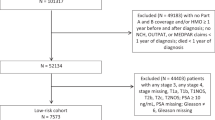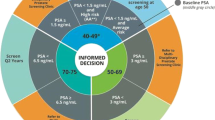Abstract
Navigation programs aim to help patients overcome barriers to cancer diagnosis and treatment. Missed clinic appointments have undesirable effects on the patient, health system, and society, and treatment delays have been shown to result in inferior surgical cure rates for men with prostate cancer (CaP). We sought to measure the impact of patient navigation on CaP clinic adherence. Patient navigators contacted patients prior to their first encounter for known or suspected CaP between 7/1/2016 and 6/30/2017. Encounters from 7/1/2014 to 6/30/2015 were used as a historical control. Patient-variables were analyzed including age, health insurance status, home address, zip code, race, ethnicity, and referring primary care clinic. Encounter-level variables included diagnosis (categorized as known or suspected CaP), date of appointment, type of appointment [new vs. return], and provider. The associations between several factors including navigation contact and these variables with missed appointment were analyzed using generalized linear mixed effects multivariate logistic regression. A total of 2854 scheduled clinic encounters from 986 unique patients were analyzed. Patient navigation resulted in a lower missed appointment rate (8.8% vs. 13.9%, OR = 0.64, IQR 0.44–0.93, p = 0.02 on multivariable analysis). Lack of health insurance (OR = 13.18 [5.13–33.83]), suspected but not confirmed CaP diagnosis (OR = 7.44 [4.85–11.42]), and Black (1.97 [1.06–3.65]) or Hispanic (OR = 3.61 [1.42–9.16]) race, were associated with missed appointment. Implementation of patient navigation reduced missed appointment rates for CaP related ambulatory encounters. Identifying risk factors for missed appointment may aid in targeting navigation services to those most likely to benefit from this intervention.
Similar content being viewed by others
References
Freeman, H. P., & Rodriguez, R. L. (2011). History and principles of patient navigation. Cancer,117(15 Suppl), 3539–3542.
Wells, K. J., Battaglia, T. A., Dudley, D. J., Garcia, R., Greene, A., Calhoun, E., et al. (2008). Patient navigation: State of the art or is it science? Cancer,113(8), 1999–2010.
Ramachandran, A., Freund, K. M., Bak, S. M., Heeren, T. C., Chen, C. A., & Battaglia, T. A. (2015). Multiple barriers delay care among women with abnormal cancer screening despite patient navigation. Journal of Womens Health (Larchmont),24(1), 30–36.
Rodday, A. M., Parsons, S. K., Snyder, F., Simon, M. A., Llanos, A. A., Warren‐Mears, V., et al. (2015). Impact of patient navigation in eliminating economic disparities in cancer care. Cancer,121(22), 4025–4034.
Charlot, M., Santana, M. C., Chen, C. A., Bak, S., Heeren, T. C., Battaglia, T. A., et al. (2015). Impact of patient and navigator race and language concordance on care after cancer screening abnormalities. Cancer,121(9), 1477–1483.
Ko, N. Y., Snyder, F. R., Raich, P. C., Paskett, E. D., Dudley, D. J., Lee, J. H., et al. (2016). Racial and ethnic differences in patient navigation: Results from the Patient Navigation Research Program. Cancer,122(17), 2715–2722.
Molfenter, T. (2013). Reducing appointment no-shows: Going from theory to practice. Substance Use and Misuse,48(9), 743–749.
Jandorf, L., Gutierrez, Y., Lopez, J., Christie, J., & Itzkowitz, S. H. (2005). Use of a patient navigator to increase colorectal cancer screening in an urban neighborhood health clinic. Journal of Urban Health,82(2), 216–224.
Christie, J., Itzkowitz, S., Lihau-Nkanza, I., Castillo, A., Redd, W., & Jandorf, L. (2008). A randomized controlled trial using patient navigation to increase colonoscopy screening among low-income minorities. Journal of the National Medical Association,100(3), 278–284.
Sullivan, C., Leon, J. B., Sayre, S. S., Marbury, M., Ivers, M., Pencak, J. A., et al. (2012). Impact of navigators on completion of steps in the kidney transplant process: A randomized, controlled trial. Clinical Journal of the American Society of Nephrology,7(10), 1639–1645.
Ferrante, J. M., Chen, P. H., & Kim, S. (2008). The effect of patient navigation on time to diagnosis, anxiety, and satisfaction in urban minority women with abnormal mammograms: A randomized controlled trial. Journal of Urban Health,85(1), 114–124.
Percac-Lima, S., Ashburner, J. M., Zai, A. H., Chang, Y., Oo, S. A., Guimaraes, E., et al. (2016). Patient navigation for comprehensive cancer screening in high-risk patients using a population-based health information technology system: A randomized clinical trial. JAMA Internal Medicine,176(7), 930–937.
Tingen, M. S., Weinrich, S. P., Heydt, D. D., Boyd, M. D., & Weinrich, M. C. (1998). Perceived benefits: A predictor of participation in prostate cancer screening. Cancer Nursing,21(5), 349–357.
Capik, C., & Gozum, S. (2012). The effect of web-assisted education and reminders on health belief, level of knowledge and early diagnosis behaviors regarding prostate cancer screening. European Journal of Oncology Nursing,16(1), 71–77.
Johnson, T. V., Goodman, M., & Master, V. A. (2007). The efficacy of written screening tools in an inner city hospital: Literacy based limitations on patient access to appropriate care. The Journal of Urology,178(2), 623–629. (discussion 629).
Dobbs, R. W., Malhotra, N. R., Caldwell, B. M., Rojas, R., Moreira, D. M., & Abern, M. R. (2018). Determinants of clinic absenteeism: A novel method of examining distance from clinic and transportation. Journal of Community Health,43(1), 19–26.
Reuland, D. S., Brenner, A. T., Hoffman, R., McWilliams, A., Rhyne, R. L., Getrich, C., et al. (2017). Effect of combined patient decision aid and patient navigation vs usual care for colorectal cancer screening in a vulnerable patient population: A randomized clinical trial. JAMA Internal Medicine,177(7), 967–974.
Genoff, M. C., Zaballa, A., Gany, F., Gonzalez, J., Ramirez, J., Jewell, S. T., et al. (2016). Navigating language barriers: A systematic review of patient navigators’ impact on cancer screening for limited english proficient patients. Journal of General Internal Medicine,31(4), 426–434.
Siegel, R. L., Miller, K. D., & Jemal, A. (2019). Cancer statistics, 2019. CA: A Cancer Journal for Clinicians,69(1), 7–34.
Dobbs, R. W., Greenwald, D. T., Wadhwa, H., Freeman, V. L., & Abern, M. R. (2017). Is prostate cancer stage migration continuing for black men in the PSA era? Prostate Cancer and Prostatic Diseases,20(2), 210–215.
Halbert, C. H., Weathers, B., Delmoor, E., Mahler, B., Coyne, J., Thompson, H. S., et al. (2009). Racial differences in medical mistrust among men diagnosed with prostate cancer. Cancer,115(11), 2553–2561.
Abern, M. R., Aronson, W. J., Terris, M. K., Kane, C. J., Presti, J. C., Jr., Amling, C. L., et al. (2013). Delayed radical prostatectomy for intermediate-risk prostate cancer is associated with biochemical recurrence: Possible implications for active surveillance from the SEARCH database. Prostate,73(4), 409–417.
Dobbs, R. W., Malhotra, N. R., Abern, M. R., & Moreira, D. M. (2019). Prostate cancer disparities in Hispanics by country of origin: A nationwide population-based analysis. Prostate Cancer and Prostatic Diseases,22(1), 159–167.
DuBard, C. A., & Gizlice, Z. (2008). Language spoken and differences in health status, access to care, and receipt of preventive services among US Hispanics. American Journal of Public Health,98(11), 2021–2028.
Moyer, V. A., & US Preventive Services Task Force, (2012). Screening for prostate cancer: US Preventive Services Task Force recommendation statement. Annals of Internal Medicine,157(2), 120–134.
US Preventive Services Task Force, Grossman, D. C., Curry, S. J., Owens, D. K., Bibbins-Domingo, K., Caughey, A. B., et al. (2018). Screening for prostate cancer: US Preventive Services Task Force recommendation statement. JAMA,319(18), 1901–1913.
Weinrich, S. P., Boyd, M. D., Weinrich, M., Greene, F., Reynolds, W. A., Jr., & Metlin, C. (1998). Increasing prostate cancer screening in African American men with peer-educator and client-navigator interventions. Journal of Cancer Education,13(4), 213–219.
Simon, M. A., Nonzee, N. J., McKoy, J. M., Liu, D., Luu, T. H., Byer, P., et al. (2013). Navigating veterans with an abnormal prostate cancer screening test: A quasi-experimental study. BMC Health Serv Research,13, 314.
Serrell, E. C., Hansen, M., Mills, G., Perry, A., Robbins, T., Feinberg, M., et al. (2019). Prostate cancer navigation: Initial experience and association with time to care. World journal of Urology,37(6), 1095–1101.
Freund, K. M. (2017). Implementation of evidence-based patient navigation programs. Acta Oncologica,56(2), 123–127.
Clark, C. R., Baril, N., Kunicki, M., Johnson, N., Soukup, J., Ferguson, K., et al. (2009). Addressing social determinants of health to improve access to early breast cancer detection: Results of the Boston REACH 2010 breast and cervical cancer coalition women’s health demonstration project. Journal of Womens Health (Larchmont),18(5), 677–690.
Davis, C., Darby, K., Likes, W., & Bell, J. (2009). Social workers as patient navigators for breast cancer survivors: What do African-American medically underserved women think of this idea? Social Work in Health Care,48(6), 561–578.
Crockett-Maillet, G. (2008). The breast cancer navigator. A new role for nurse practitioners. Advance for Nurse Practitioners,16(1), 53–54, 56.
Author information
Authors and Affiliations
Corresponding author
Ethics declarations
Conflict of interest
The authors declare that they have no conflicts of interest.
Additional information
Publisher's Note
Springer Nature remains neutral with regard to jurisdictional claims in published maps and institutional affiliations.
Rights and permissions
About this article
Cite this article
Dobbs, R.W., Stinson, J., Vasavada, S.R. et al. Helping Men Find Their Way: Improving Prostate Cancer Clinic Attendance via Patient Navigation. J Community Health 45, 561–568 (2020). https://doi.org/10.1007/s10900-019-00776-w
Published:
Issue Date:
DOI: https://doi.org/10.1007/s10900-019-00776-w




